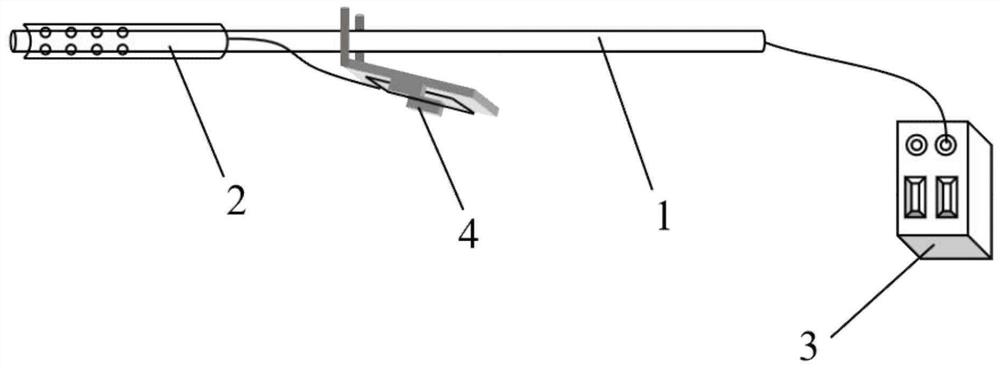Intracranial stimulation and recording system and preparation method thereof
A recording system and laser technology, applied in the field of neuroscience, can solve the problems of experimental body damage, easy to cause neuroinflammation, brain tissue damage, etc., to reduce neuroinflammation, improve mechanical compliance, and avoid injury.
- Summary
- Abstract
- Description
- Claims
- Application Information
AI Technical Summary
Problems solved by technology
Method used
Image
Examples
Embodiment 1
[0046] This embodiment provides an intracranial stimulation recording system, such as figure 1 As shown, the intracranial stimulation recording system includes a flexible optical fiber 1 , a flexible deep brain electrode 2 and a laser 3 . The flexible deep brain electrode 2 is fixed to the front end of the flexible optical fiber 1 by a clamp 4, and the flexible part of the flexible deep brain electrode 2 is naturally drooped by gravity, and is attached to the flexible optical fiber due to capillary tension. 1 surface. The laser 3 is connected to the rear end of the flexible optical fiber 1 as a light source for light stimulation.
[0047] Such as Figure 2hAs shown, the flexible deep brain electrode includes a substrate layer 5 , a metal wiring layer 6 , an insulating layer 7 , a metal electrode layer 8 and an encapsulation layer 9 arranged from bottom to top. Preferably, the substrate layer 5 is made of silk protein for supporting the metal wiring layer 6 , the insulating ...
Embodiment 2
[0049] This embodiment provides a method for preparing the above-mentioned intracranial stimulation recording system, the method comprising the following steps:
[0050] S1: Prepare a clean substrate 10 for use.
[0051] Preferably, the substrate 10 is a single-polished silicon wafer with a thickness of 300-500 μm (for example, 450 μm), and the single-polished silicon wafer is cleaned for later use (see Figure 2a ).
[0052] S2: Prepare a nickel sacrificial layer 11 on the substrate 10 prepared in step S1.
[0053] Specifically, the photoresist (such as SU-8 photoresist) is patterned by photolithography on the substrate 10 prepared in step S1, and a layer with a thickness of 50-150nm (such as 100nm) metallic nickel, the metallic nickel is carried out lift-off process patterning to obtain nickel sacrificial layer 11, and described nickel sacrificial layer 11 is used for subsequently releasing flexible deep brain electrode from described substrate 10 (see Figure 2b ).
[0...
PUM
 Login to View More
Login to View More Abstract
Description
Claims
Application Information
 Login to View More
Login to View More - R&D
- Intellectual Property
- Life Sciences
- Materials
- Tech Scout
- Unparalleled Data Quality
- Higher Quality Content
- 60% Fewer Hallucinations
Browse by: Latest US Patents, China's latest patents, Technical Efficacy Thesaurus, Application Domain, Technology Topic, Popular Technical Reports.
© 2025 PatSnap. All rights reserved.Legal|Privacy policy|Modern Slavery Act Transparency Statement|Sitemap|About US| Contact US: help@patsnap.com



